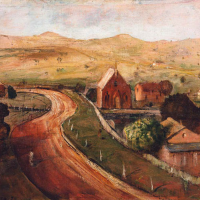21. LLOYD REES

When Lloyd Rees died in 1988 the nation lost one of its most loved and admired artists, lauded in that year by the Australian Bicentennial Authority as one of two hundred people who made Australia great. Despite the public outpourings of grief and recognition, Rees had not always been held in such esteem. During his long career he slipped in and out of prominence, working for many years in relative obscurity as artistic taste moved on from the fine draughtsmanship that marked his paintings and signature drawings. He was a man of great wisdom, a gifted teacher and stalwart friend to many in the art world and the wider community. Will Ashton (1881-1963), Director of the Art Gallery of New South Wales, presented a retrospective of Reess work in 1942 and the artist seemed destined for great things. But the war brought change, disruption and in its wake, the rise of modernism and the challenge of abstraction. A younger generation of artists embraced the new styles and those who produced modest works of a domestic scale fell from the public eye. After the war, Rees took a post at the University of Sydney, teaching drawing and art history in the school of architecture. Less dependent on commercial work and major sales, he was happy to work away out of the public eye. But while his work might not have been at the forefront of advanced taste, he had a firm place in the in the broader art community, winning the 1950 Wynne prize with The Harbour from McMahons Point and the 1951 Commonwealth Jubilee Art Prize with Sydney.
In 1947 Lloyd Rees built a holiday cottage at Werri Beach, near Gerringong on the South Coast of New South Wales. With a comfortable base to work from, he produced a series of paintings of the rolling hills and coastal landscapes of the Illawarra, including what is perhaps his best-known work, The Road to Berry, acquired by the Art Gallery of NSW in the same year. The early 1950s were productive years for Rees, able to balance his work at the university with extended travel around the state and, increasingly, overseas to France and Italy. In Europe he was able to refine his interest in the balance between the natural landscape and the built environment. He was a highly skilled architectural draughtsman, able to resolve complex built forms with a light and elegant touch. The hill towns of Italy, with their jumbled mass of ancient houses and fortifications, were a challenge he relished and he brought his own interpretation to subjects that had intrigued artists for centuries. The lessons learned in Europe could be applied to the simpler forms of the Australian vernacular architecture of the country towns and villages encountered on his regular travels between Sydney, the south coast and his wifes home town of Bathurst.
In the years after the Second World War a number of artists had cast fresh eyes on the small towns of rural Australia, most notably Russell Drysdale (1912-1981) whose depictions of Hill End, Sofala and West Wyalong had come to define a whole sub-genre of landscape painting. At Gunning, a straggling town in the open grazing country south west of Goulburn, Rees played with the classic elements that gave such places their appeal a wide, winding road formed by bullock drays and flocks of sheep, a few cottages hunkered down under spreading iron roofs and a lone church providing a moment of substance and solemnity in a dry and open landscape. Rees has, in a few brief strokes, captured the essence of a town at once quite specific and yet a model for a hundred such places dotted across the country.
Gavin Fry